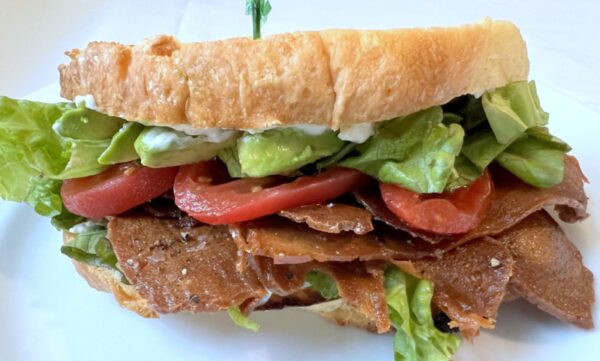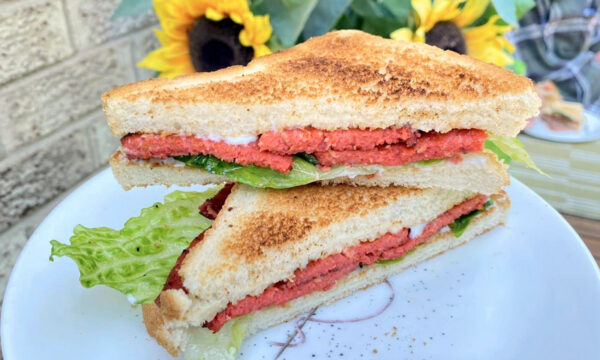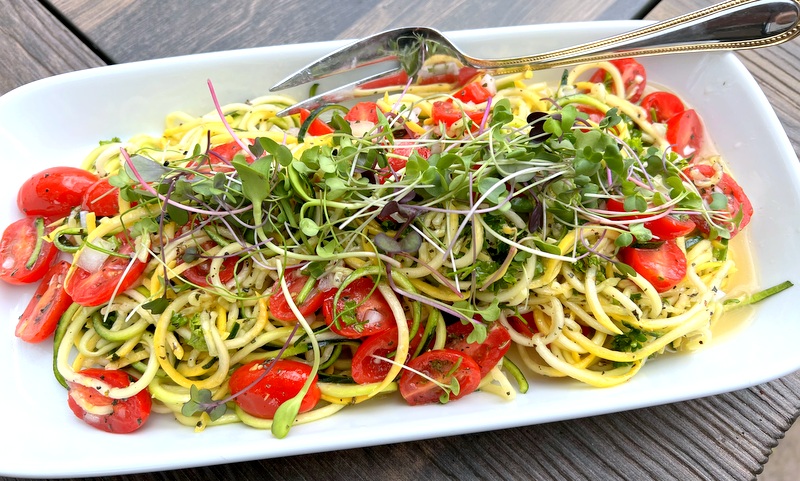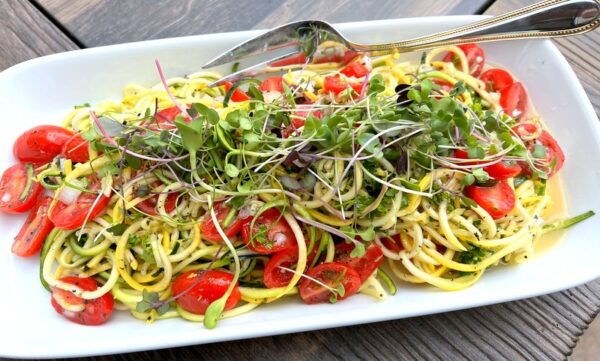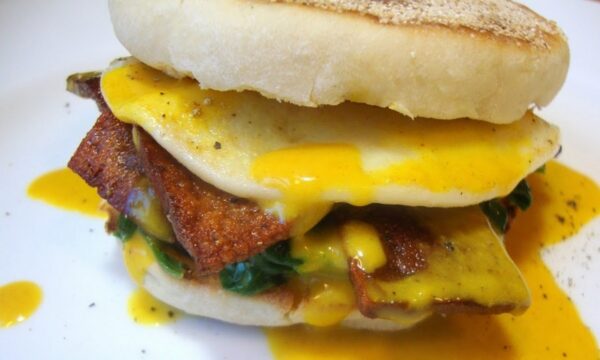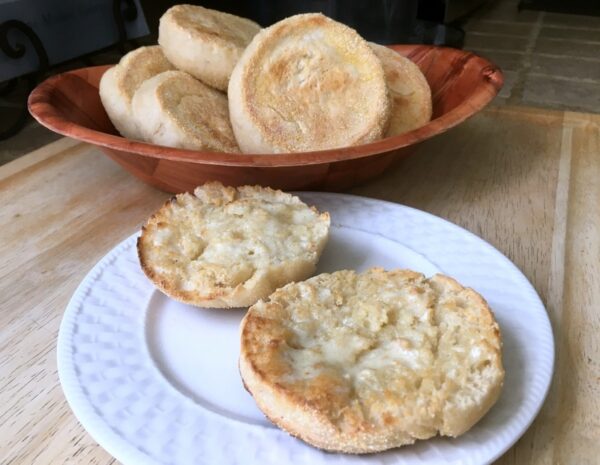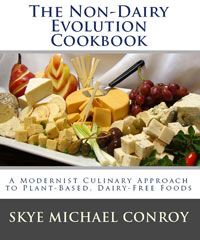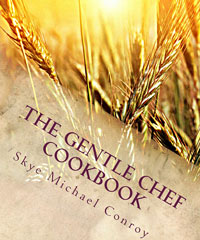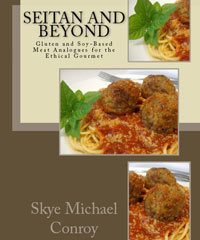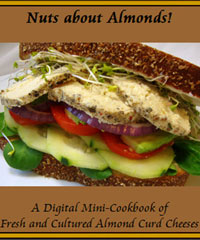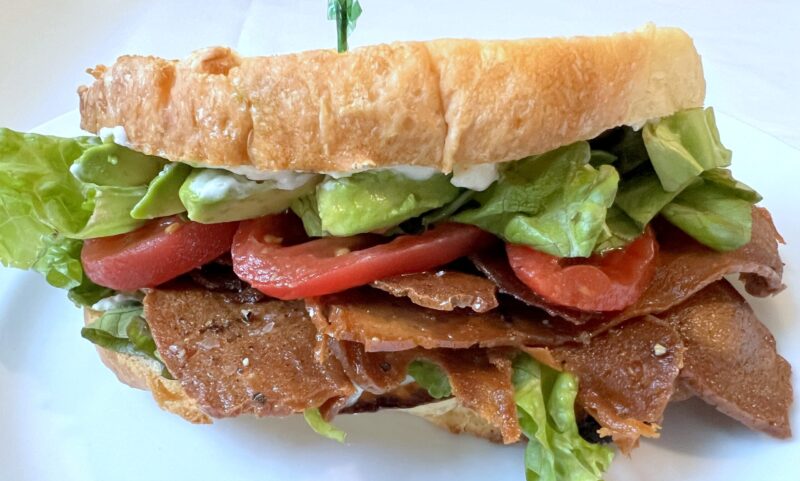
The premium vegan bacun recipe from my published cookbooks is awesome. It’s beautifully marbled, which adds a bit of visual realism; but sometimes a quicker and easier preparation is appreciated. This shortcut recipe produces a vegan bacun with no marbling. Omitting the second marbling dough makes this recipe much easier and faster to prepare (your mouth won’t know the difference). The prepared sliced bacun fries up extra crisp and delicious in the skillet or oven. A food processor is requiring for mixing the dough and an electric pressure cooker (e.g., Instant Pot) is ideal for cooking preparation (conventional steaming is an alternate option).
Ingredients
- 5 oz/140 grams pressed and crumbled extra-firm tofu (not silken tofu)
- 1 tablespoon onion powder
- 1 tablespoon smoked paprika
- 1½ teaspoon garlic powder
- 3 tablespoons tamari, soy sauce or Bragg Liquid Aminos™
- 1 tablespoon vegan Worcestershire sauce
- 4 teaspoons dark brown sugar
- 2 teaspoons hickory liquid smoke
- 1 teaspoon browning liquid (e.g., Gravy Master; Kitchen Bouquet)
- ½ teaspoon sea salt or kosher salt
- 1¼ cup (175 grams) vital wheat gluten (scoop and level)
- ½ cup (120 ml) water
Dry Rub
- 1 teaspoon coarse ground black pepper; and/or
- 1 tablespoon dark brown sugar
Preparation
Press and blot the tofu to remove as much water as possible; then crumble.
In a food processor fitted with a standard chopping blade or plastic dough blade, add all ingredients except for the gluten and water. Process as smooth as possible.
Add the gluten and water and process for 2 to 3 full minutes or until the mixture comes together into an elastic ball of dough. If the dough is not coming together after two and a half minutes, add 2 tablespoons vital wheat gluten and process until the dough comes together.
Shape the dough into a thick, flattened rectangle on a sheet of extra-wide, heavy-duty aluminum foil. Sprinkle with the black pepper and/or brown sugar. Wrap the dough in the foil to create a flat package. Fold then ends inwards to seal (like wrapping a holiday present). Rewrap in a second sheet of foil for reinforcement.
Pressure Cooker
Add a few cups of water to the cooker and place the container on the trivet. Seal the lid, close the steam valve, and cook on Manual/High for 1 hour. Turn off the cooker and let the steam pressure naturally release for 30 minutes; do not open release valve to release pressure! Remove the container from the cooker; let cool in the mold with the foil in place and then chill to firm and enhance texture before slicing and frying.
Conventional Steamer with Basket
Add water to the cooking pot just below the steamer basket. Bring to a rapid boil over high heat. Set the wrapped container in the basket and put the lid in place. The heat can be reduced to medium to conserve energy as long as the water continues to rapidly boil. Steam for 1 hour and 30 minutes. Check every 30 minutes and add very hot water to the pot as needed to replace water lost from evaporation. Do not let the pot boil dry! After cooking, remove the container from the steamer; let cool in the mold with the foil in place and then chill to firm and enhance texture before slicing and frying.
Finishing the Bacun
Slice the bacun as thinly as possible for the crispest texture after frying (unless you prefer a thicker cut). When sliced thin, the bacun may tatter a bit, but this only adds to the authentic finished texture and appearance.
To oven fry the bacun, preheat the oven to 375°F (190°C). Line a baking sheet with aluminum foil for easy cleanup and arrange the slices in a single layer. Generously brush the slices on both sides with cooking oil. Bake for 15 to 20 minutes. Transfer to a plate lined with paper towels to blot any excess oil.
To skillet fry the bacun, pour a generous layer of cooking oil in a large skillet over medium-high heat (to prevent burning, avoid frying it at a high temperature). Cook until lightly browned on both sides. Transfer to a plate lined with paper towels to blot any excess oil.
As the bacun cools, it will crisp up. Thicker slices will retain a chewy texture.
Tips from Chef Skye
It’s helpful to put a heavy object, such as a cast-iron skillet, on the foil package to compress it as it cools and keep the slab of bacun flat. This will also help to compress the bacun and improve its texture.
Print Recipe
Shortcut Crispy Bacun - 100% Vegan of course!
Votes: 0
Rating: 0
You:
Rate this recipe!
|
|
Votes: 0
Rating: 0
You:
Rate this recipe!
|
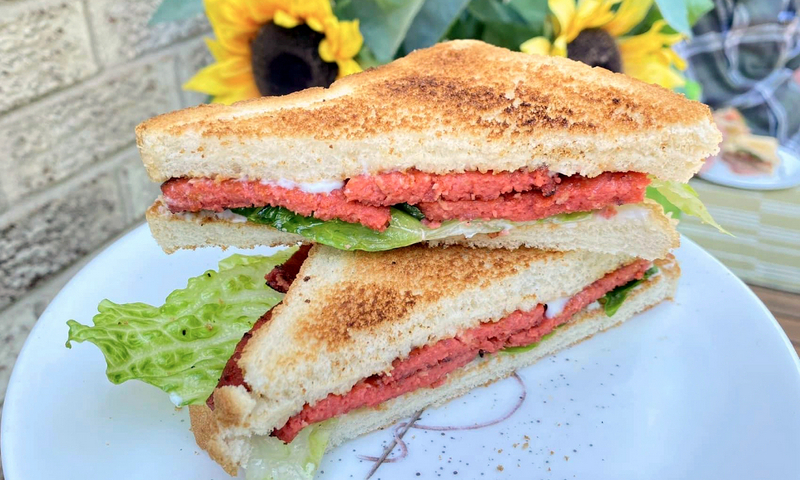
Spam is a salty and savory processed luncheon meat made from ham which became popular in American and Polynesian culture during WWII and into the present day. My vegan, compassionate version is made from vital wheat gluten, tofu and select seasonings. Typically, Spam is sliced or diced and pan-fried until golden brown and crisp around the edges. Like Spam, Gentle Spam can be used as a luncheon meat or used in a variety of recipes in place of ham.
This recipe requires a total of 5 ounces/200 grams of pressed and thoroughly blotted extra-firm tofu (weighed after pressing). Typically, ½ block of commercial extra-firm tofu will yield 5 ounces/200 grams after pressing and blotting.
The recipe also requires a food processor; a pressure cooker (e.g., Instant Pot) or conventional steamer; and a square or rectangular silicone or metal mold which will hold at least 2 cups of liquid (molds used for preparing vegan cheese are ideal). Do not use plastic or glass!
A scant amount (⅛ teaspoon) of red food color is used to simulate the nitrate-pink color of the product. Regrettably, natural red pigments won’t work. If you’d rather not use artificial red food color (FD&C red, which is derived from petroleum, not animals), simply omit, although the finished product will be brown in color. You can add 1 teaspoon of paprika for color, although this will produce an orange hue.
Processor Ingredients
• 1 cup (240 ml) water
• 3 oz/85 grams pressed and crumbled extra-firm tofu (not silken tofu)
• 4 teaspoons nutritional yeast flakes
• 4 teaspoons organic sugar
• 1 tablespoon onion powder
• 1½ teaspoon garlic powder
• 1¼ teaspoon sea salt or kosher salt
• ½ teaspoon ground white pepper
• 2 tablespoons refined coconut oil, melted (not virgin oil)
• 1 tablespoon tamari, soy sauce or Bragg Liquid Aminos™
• 2 teaspoons hickory liquid smoke (or less if sensitive to smoke flavor)
• Optional for pink color: ⅛ teaspoon red food color (FD&C)
• 1 cup (140 grams) vital wheat gluten (scooped and leveled)
Marbling Ingredients
• 2 oz/60 grams pressed and finely crumbled extra-firm tofu (not silken tofu)
• ¼ teaspoon sea salt or kosher salt
• ¼ teaspoon onion powder
Preparation
In a small bowl, toss the marbling tofu bits with the salt and onion powder. Set aside.
In a food processor, add ½ of the water, the 3 ounces of crumbled tofu, and the remaining processor ingredients except for the gluten. Process until liquefied.
Add the gluten and the remaining water and process for 1 full minute or until the dough comes together. Add the marbling tofu bits and pulse a few times until dispersed through the dough.
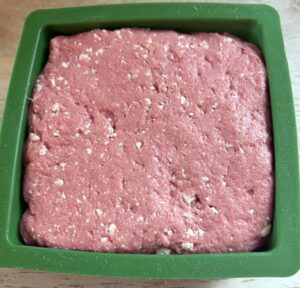
Pack evenly into the silicone or metal mold and then wrap securely with foil.
Pressure Cooker: Add 2 to 3 cups of water to the pressure cooker and put the trivet in place. Cook on manual high for 1 hour. Turn off the cooker and let the steam pressure naturally release for 30 minutes – do not open release valve to release pressure! After cooking, remove the container from the cooker; let cool in the mold with the foil in place and then chill to firm and enhance texture before slicing and frying.
Conventional Steamer with Basket: Steam the container over boiling water on high heat with the lid in place for 1 hour and 30 minutes. Check occasionally to replace water lost to evaporation with very hot water. Do not let boil dry! After cooking, remove the container from the steamer; let cool in the mold with the foil in place and then chill to firm and enhance texture before slicing and frying.
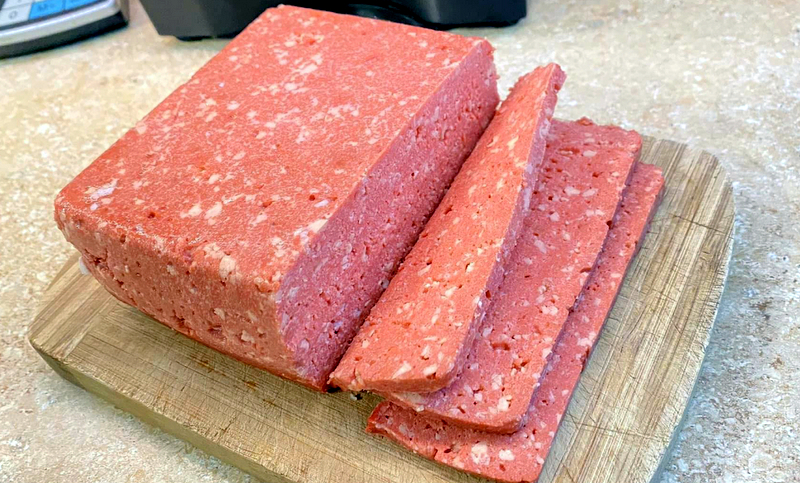
Prepared Gentle Spam ready for pan-frying in a non-stick oiled skillet.
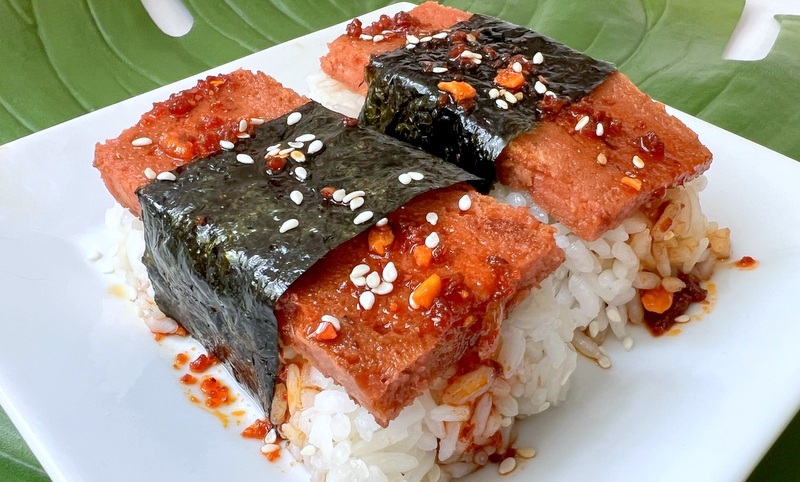
A Hawaiian favorite, vegan- style. Gentle Spam Musubi consists of pan-grilled Gentle Spam over sticky rice, wrapped in nori seaweed and topped with crispy garlic chili sauce and a sprinkle of sesame seeds.
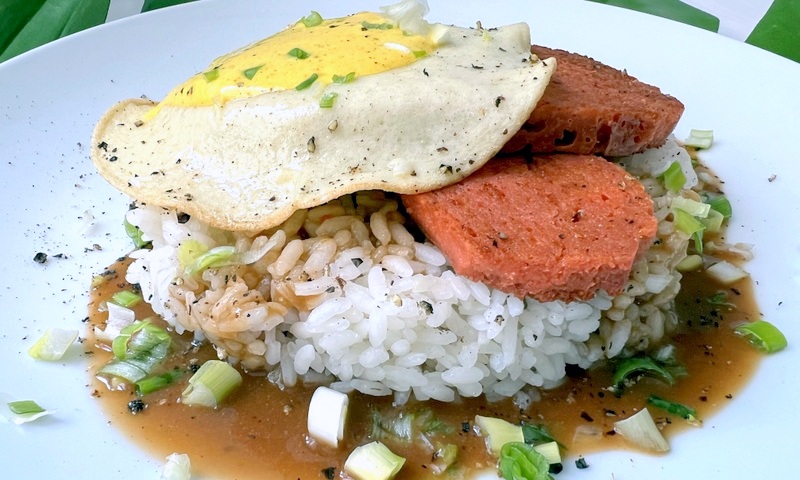
Hawaiian Spam Loco Moco is an island breakfast favorite. My compassionate version consists of pan-grilled Gentle Spam over sticky rice with brown vegan gravy and chopped scallions, and topped with a sunnyside-up “egg” (from my new digital cookbook What’s Cookin’ Too)
Votes: 0
Rating: 0
You:
Rate this recipe!
|
|
Votes: 0
Rating: 0
You:
Rate this recipe!
|
Vegan Eggz Essentials – Chef’s Proprietary Formula
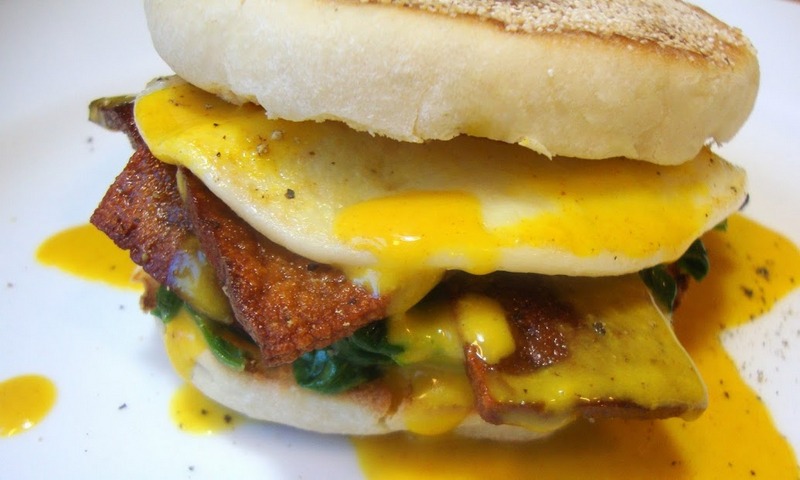
Basic skillet-cooked eggz whites with broken yolx, sautéed baby spinach and tofu bacon.
Regrettably, due to supply chain issues, Modernist Pantry has discontinued my own Vegan Eggz Essentials product, which consisted of two individual ingredients (Eggz Essentials A and Eggz Essentials B), conveniently packaged and sold together. These two ingredients are used in several recipes in my cookbooks, most notably my egg analogue recipes in Cook and Let Live.
While I’m disappointed that my product is no longer available, the individual ingredients are still available for separate purchase from a few sources. I have decided to publish my formula for your convenience. I’ve also included a basic eggz scramble recipe and an eggz white only recipe. Whenever you come across a recipe in my cookbooks that call for these ingredients, now you have the substitute.
Eggz Essentials A is a specific form of methylcellulose (plant fiber). Methylcellulose is the food science name for purified plant cellulose or fiber. Like cellulose, it is non-digestible, non-toxic, and non-allergenic. Methylcellulose, as an ingredient in food, has the unique property of setting when hot, which makes it particularly useful for preparing egg analogues. Methylcellulose is sold under a variety of names and in a variety of forms, and each form reacts differently in cooking. In my recipes, it can only be replaced with:
- Methocel® A4C Food Grade (methylcellulose A4C) available from ModernistPantry.com, Amazon.com, and potentially other online sources; or
- Methylcellulose HV or LV (high viscosity/low viscosity) available from Modernist Pantry.com, Amazon.com, and potentially other online sources. In Europe, methylcellulose HV is identified as methylcellulose e-461.
Eggz Essentials B (formerly high-acyl gellan gum) is being replaced with kappa carrageenan. Kappa carrageenan functions in a similar manner to gellan gum in this application; is more affordable; and is much easier to access. Kappa carrageenan, which is derived from seaweed, is commonly used in vegan cheesemaking.
Scrambled Eggz
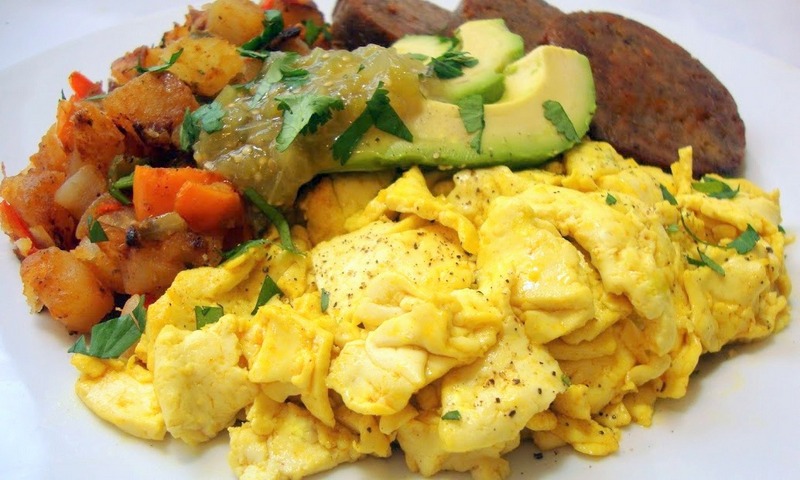
Cooked scrambled eggz bear a remarkable resemblance to real cook scrambled eggs – with no tofu required. The eggz mixture consists of Vegan Eggz Essentials blended with plain non-dairy milk and other natural ingredients for flavor and color and the mixture is cooked just as you would real beaten eggs.
The scrambled eggz mixture needs to be blended and refrigerated for a minimum of 2 hours for proper setting when cooked, so plan accordingly. For breakfast preparation convenience, blend and chill the eggz mixture the night before.
Please note that the scrambled eggz mixture is only intended for preparing scrambled eggz and omelets; as a binder in some cooked foods; or when used as an eggz dip for battering or breading (dilute with plain non-dairy milk to thin the viscosity). The formula needs to be customized for eggz quiches and frittatas by adding 2 tablespoons of cornstarch or potato starch to the mixture.
The scramble mixture will not work as an egg replacer in baked goods (breads, cakes, muffins, etc), or in other recipes that rely on the protein structure of eggs to create lift (such as soufflés). For baked goods you may want to experiment with aquafaba, commercial egg replacers, flaxseed emulsion, bananas or applesauce.
After the eggz have set, try folding in some shredded non-dairy cheese that melts before serving. If desired, top with sautéed vegetables; chopped herbs; or slices of fresh avocado and salsa. For a classic American breakfast, serve with hash browns, vegan bacon or sausages and whole grain toast with non-dairy butter. For the best texture experience, serve hot! This recipe yields about 4 servings.
Eggz Ingredients
- 2 cups (480 ml) plain unsweetened non-dairy milk
- 2 Tablespoons Eggz Essentials A (methylcellulose; see above description)
- 1 T nutritional yeast flakes
- 2 teaspoons Eggz Essentials B (kappa carrageenan)
- 1 teaspoon kala namak (Himalayan black salt)
- scant ¼ teaspoon paprika
- scant ¼ teaspoon ground turmeric
Preparation
Add the eggz ingredients to a blender and process for 20 seconds (a mini-blender is ideal for this purpose). An immersion blender can also be used. The mixture will be pale in color (the “egg” color will develop when the mixture is cooked). Resist adding more turmeric or paprika as this will create a very unnatural finished color appearance. Please note that the raw mixture will be thicker than real beaten eggs.
Transfer the mixture to a sealable container and chill for a minimum of 2 hours. This is essential in order for the mixture to set properly when cooked. The blended mixture can be stored in the refrigerator for up to 1 week and then used to prepare scrambles at your convenience. After chilling, the mixture will be quite thick and somewhat gelatinous. Before using, stir vigorously to loosen the mixture and break up any air bubbles that formed during blending. If the mixture has been chilled for extended periods, let it warm up to room temperature a bit. This will also help loosen the mixture and improve flow.
Mist a non-stick skillet with cooking oil or melt a tablespoon or two of non-dairy butter or margarine over medium-low gas flame (electric stoves may require a higher setting to heat the skillet sufficiently). Spread the desired amount of the eggz mixture in the skillet (½ cup for each serving). Increase the heat to medium.
After thirty seconds, push against the edge of the mixture with a flexible spatula to test for setting. If still liquid check again in thirty seconds. Once the mixture begins to set, push and fold the edges in towards the center with a flexible spatula. Break up the mixture with the edge of the spatula and continue to fold and cook until the eggz are set. Plate, season and garnish as desired; serve immediately.
Eggz Whites
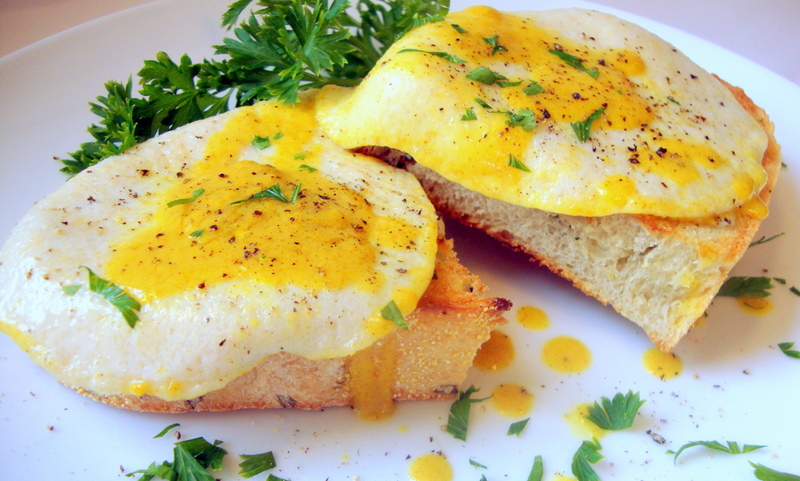
Cooked eggz whites bear a remarkable resemblance in appearance, flavor and texture to real cooked egg whites. Eggz whites can be used for preparing skillet-cooked eggz, oven-cooked eggz, and eggz whites omelets. Cold-served eggz, such as deviled eggz, are prepared differently using agar as a setting agent (please see appropriate recipes in my cookbooks). Eggz whites consist of Vegan Eggz Essentials blended with plain non-dairy milk and kala namak to impart the characteristic egg-like flavor and aroma. No tofu is required.
The eggz whites mixture needs to be blended and refrigerated for a minimum of 2 hours before cooking, so plan accordingly. For breakfast preparation convenience, blend and chill the eggz mixture the night before. This recipe yields 5 to 6 eggz whites (the recipe can be doubled or tripled if desired).
Please note that the eggz whites mixture is only intended for preparing skillet-cooked eggz, oven-cooked eggz, and eggz whites scrambles and omelets. While it will work as a binder in some cooked foods, it doesn’t have the structure for creating fluffy meringues (aquafaba is recommended for meringues). It also will not work as an egg white replacer in baked goods (breads, cakes, muffins, etc.) or in other recipes that rely on the protein structure of eggs to create lift (such as soufflés). For baked goods you may want to experiment with aquafaba, commercial egg replacers or flaxseed emulsion.
Ingredients
- 1 cup plain unsweetened non-dairy milk
- 1 Tablespoon Eggz Essentials A (methylcellulose; see above description)
- 1 teaspoon Eggz Essentials B (kappa carrageenan)
- ½ teaspoon kala namak (Himalayan black salt)
Preparation
Add the ingredients to a blender and process for 20 seconds (a mini blender is ideal for this purpose). An immersion blender can also be used. Please note that the raw eggz whites mixture will be opaque and much creamier and thicker than real egg whites.
Transfer the mixture to a sealable container and chill for a minimum of 2 hours. This is essential in order for the mixture to set properly when cooked. The blended mixture can be stored in the refrigerator for up to 1 week and then used at your convenience. After chilling, the mixture will be quite thick and somewhat gelatinous. Before using, stir vigorously to loosen the mixture and break up any air bubbles that formed during blending. If the mixture has been chilled for extended periods, let it warm up to room temperature a bit. This will also help loosen the mixture and improve flow.
Cooking the Eggz Whites
Mist a non-stick or cast-iron skillet with cooking oil over a medium-low gas flame. If using an electric stove, a higher setting may be needed to preheat the skillet sufficiently.
Vigorously stir the chilled eggz whites to loosen the mixture and remove any air bubbles. For each eggz white, spoon 2 generous tablespoons of the mixture into the skillet. If necessary, use the back of a spoon to spread the mixture into a circular or oval shape. Increase the heat to medium and cook until the whites are firm to the touch. Flip the eggz with a flexible spatula and cook for another 10 to 15 seconds. Transfer to a serving plate, drizzle with the broken yolx mixture (recipe follows) and season and garnish as desired. Serve immediately.
Broken Yolx
Broken yolx is a rich, golden liquid egg yolk alternative that remarkably resembles lightly cooked egg yolk. It’s superb for drizzling over cooked eggz whites or silken tofu to create a “broken yolk” effect. It’s also wonderful for dipping toast, vegan bacon or sausage. This recipe yields about 1 cup. The recipe can be doubled if desired and stored in the refrigerator for up to 7 days and then reheated at your convenience.
Ingredients
- 2 Tablespoons nutritional yeast flakes
- ¾ teaspoon sodium alginate, guar gum or xanthan gum
- ½ teaspoon ground turmeric
- ½ teaspoon paprika
- ¼ teaspoon kala namak (Himalayan black salt)
- 2 Tablespoons non-dairy butter or margarine
- 1 cup plain unsweetened non-dairy milk
Preparation
In a small dish, combine the nutritional yeast, alginate or gum, turmeric, paprika and kala namak. In a small saucepan, melt the butter or margarine over low heat. Whisk in the mixed dry ingredients to create a paste. In small increments, whisk in the milk until smooth. Increase the heat to medium-low and stir occasionally until the mixture is heated through. Reduce the heat back to low to keep warm until ready to serve, stirring occasionally.
Print Recipe
Vegan Eggz Essentials - Chef's Proprietary Formula
Votes: 0
Rating: 0
You:
Rate this recipe!
|
|
Votes: 0
Rating: 0
You:
Rate this recipe!
|
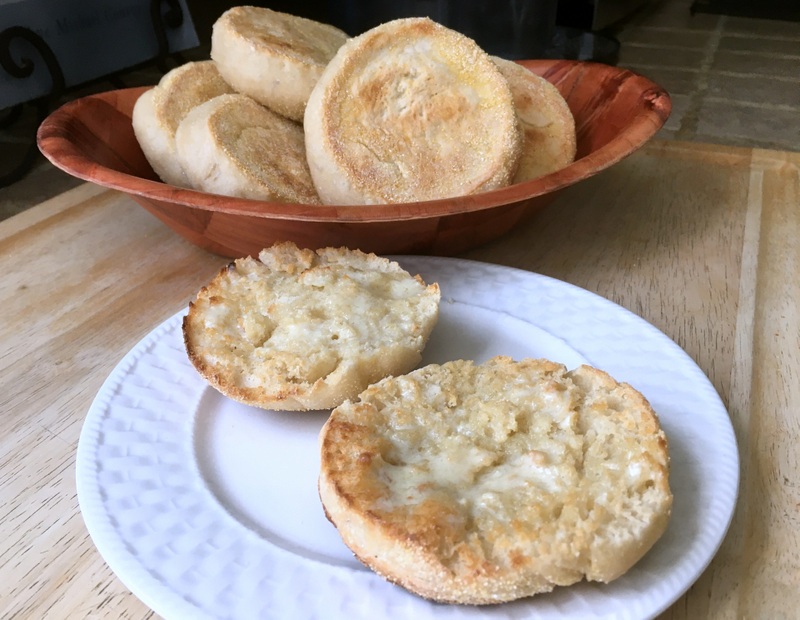
The recipe can now be found in my new cookbook, What’s Cookin’ Too
Print Recipe
English Muffins
Votes: 0
Rating: 0
You:
Rate this recipe!
|
|
Votes: 0
Rating: 0
You:
Rate this recipe!
|


